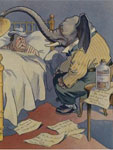Essential Questions Are Key
I always start my planning with what I want students to know and be able to do at the end of the unit. Once I have identified my objectives, then I create an essential question that is worded to get students excited about the unit based on what they already know about themselves and the world and how this new information might enrich those understandings. A few books to help understand why and how to write essential questions are Teaching History with Big Ideas () and What’s the Big Idea? ().
Essential Question Ideas:
Essential questions should have multiple answers and provide some connection to students’ lives right away without any background knowledge. They should promote passionate debate that grows richer as more information is learned. In other words, these questions help engage students while simultaneously challenging them. Some examples include:
-
- Is the history of America one of progress or regress?
- What role, if any, does the federal government have in ensuring the safety and well being of its citizens? (from Twitter user teacherromeyn)
- How do societies respond to economic change? (from Twitter user 7askretting7)
Once you've developed your essential questions, build your lesson plans around them. My students have found both of the following example activities engaging, and they can lead to a more in-depth investigation of the Progressive movement.
Idea #1: Progressive Awards
Description:
Your class has been chosen to serve as the awards committee for the “Progressive Awards.” The final product is an awards show and live Twitter reflection to highlight the people—past and present—who have best championed the ideas of the Progressive movement. Knowledge objectives: Students will . . .
- Describe the main people, events, and ideas of the Progressive Era; and
- Identify the living legacy of the Progressive movement today.
Skill objectives: Students will . . .
- Evaluate the various people based on the awards criteria identified by teacher or by class;
- Defend a position using evidence and historical context; and
- Reflect on learning process.
Background information (context): You will . . .
- Present an in-class lecture or flipped class video; and
- Guide students through text or supplemental reading about the time period.
Preparation for awards show (research and writing):
You will . . .
- Define the award criteria beforehand or as a class (see handout for examples).
- Have each student research four people (two past and two present) for a specific category and serve as their advocate at the selection committee meeting. Research can be assigned as homework or spend one class day in the computer lab. Students can consult books and websites. Pre-selecting useful resources may be necessary depending on your students’ experiences and abilities with research).
- Conduct a selection committee meeting where students present their three-minute speeches to small groups based on specific award (i.e., Social Justice Award, Government Transparency Award, Muckraker Award, etc.). Another idea is to have students record their three-minute arguments and the teacher can post them for viewing as a homework assignment.
- Select four finalists.
Awards show (product and reflection):
This will be . . . A final review of the information along with a way to summarize the basic categories of each award.
Roles for students:
-
- Master of Ceremonies (“emcee”);
- Finalists (two past and two present), who reread their three minute presentations (or replay the videos they made);
- Voters, who vote via Poll Everywhere or another voting tool; and
- Live tweeters using backchannel hashtag.
Follow-up:
You can . . . Present the complexities within each movement in the Progressive era. For example, you could discuss the racism within the women’s movement or the anti-immigrant position within the prohibition movement. I like to get students to think one way for a whole day and then confront them with information that challenges what they’ve previously learned. Spending one follow-up day on the contradictions within a particular movement creates the constructive discomfort that leads to real learning for students.
Idea #2: Progressive University
Description:
Your class must create a “Progressive University.” Students use their knowledge of the Progressive era to choose the departments at the university, the classes within these departments (along with the outline of a syllabus with readings), and the professors who will teach each class. One example might be the Department of Social Justice with classes on Labor Rights, Women’s Rights, and Racial Equality taught by Samuel Gompers, Carrie Chapman Catt, and W.E.B. DuBois respectively (see handout). Knowledge objectives: Students will . . . Describe the main people, events, and ideas of the Progressive era. Skill objectives: Students will . . . Organize information into categories and assess importance of people and ideas. Background information (context): You will . . .
- Provide in-class lecture or flipped-class video; and
- Offer text or supplemental reading about the time period.
Classwork:
Students will . . .
- Decide on departments by assessing which causes were considered most important at the time;
- Decide on the courses by breaking down the larger causes into smaller pieces;
- Decide on the professors by selecting the most important actors for a cause; and
- Select which course to highlight for the course outline and readings, and seek out contemporary readings (readings from the time) that would support the course topics.
Possible products:
Students will . . .
- Create a screencast of their university, course outlines, and readings, explaining their choices;
- Film a television advertisement for their university; or
- Write an essay on the essential question that guides the project, drawing on what they've learned in their research.
Footnotes
Grant, S.G. and Jill M. Gradwell, ed. Teaching History with Big Ideas: Cases of Ambitious Teachers. Lanham, MD: R&L Education, 2010. Burke, Jim. What's the Big Idea?: Question-Driven Units to Motivate Reading, Writing, and Thinking. Portsmouth, NH: Heinemann, 2010.
